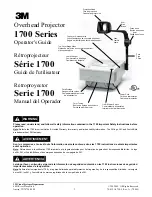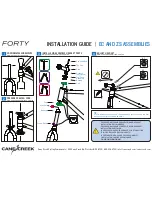
audio spectrum (below 30 Hz and above 8 kHz), the response is more than
acceptable for all but the most critical applications. Compared to commonly
available existing wireless systems, the TM400 is uniquely well suited for test
and measurements, and also makes an excellent general use, wireless micro-
phone system.
Value
The $1,890 MSRP may seem high at first glance, especially compared to
the cost of a few high-quality cables. However, when working in union halls
or other facilities where stringing lots of cable can be costly, and in relation to
other wireless systems that may not offer a “measurement-quality” transmis-
sion path, the TM400 system is well priced. One feature we'd like to see in
the future is a digital output, such as S/PDIF or AES-EBU, which would allow
users to bring the signal into our measurement system without the need for
an additional A-to-D conversion.
After testing the Lectrosonics TM400, we found it to be a very conve-
nient tool well suited for general tests and measurements in the field. We
recommend using the unit at live events such as theater, amphitheater, and
sports facility applications where long cable runs can be time consuming.
We found that any disadvantages of this system are small when compared
to the practical considerations of working with large or complex sound
systems or venues.
NAVITAR HAS
been making high-quality projection lenses for some time. I
used its slide projector lenses exclusively in my previous rental & staging career,
and its X-Y adjustment, short-throw Gold Series lenses were ideal for aligning
and converging stacks of 35 mm slide projectors.
Navitar got into the LCD and DLP projector game by purchasing Buhl Optical
of Pittsburgh, PA, a number of years back. Buhl had a nice business with after-
market lenses for installation LCD and DLP projectors for many years. However,
there are an awful lot of LCD and DLP projectors out there with fixed lenses, and
chances are many of the people who bought them really wish that a shorter or
longer lens had been available at the time.
Navitar’s ScreenStar conversion lenses are intended for LCD and DLP projec-
tors that don’t offer interchangeable lenses. They come in four sizes, including a .65x and a 1.5x model.
All four versions must be securely mounted in front of the original projector lens.
Design
The majority of low-cost projectors are usually equipped with a varifocal lens that provides a limited
zoom ratio of 1.2:1 or 1.3:1. Navitar’s solution is to provide what we used to call a telextender lens ele-
ment — it’s not a true zoom or telephoto lens, just a screw-on front element that changes the focal
length. Here, the design is simply an extender lens with a thin bracket that can be attached to any sur-
face with a couple of small screws.
Of course, you have to make sure that the rear lens element on any of these extenders is aligned cor-
rectly with the projector’s front lens element. That may require some ingenuity on your part to devise a
support for the lens extender bracket. Unfortunately, Navitar can’t make direct projector brackets —
there are just too many different models out there to support.
Performance
I hooked up the two test lenses in front of an Optoma H30 compact DLP projector. Once I was able
to come up with a secure mount for the lenses, I had to use a fine text pattern and grid pattern to make
sure the extender and projector lens elements were centered and parallel to each other.
A couple things happen to projected images when using extender lenses, and one of them is entirely
predictable. First, the light output will change as more lens elements are added. With the “un-extended”
Optoma projector, I measured 185 lux on my office screen. Adding the SSW08 dropped light output to
130 lux, but expanded the image size from 68 inches to 82 inches.
Switching to the SST120 lens reduced the image size to 55 inches and resulted in a brightness reading
of 251 lux. Brightness uniformity measured 74.8 percent with the SSW08 and measured 78.3 percent with
the SST120, so you won’t see a noticeable drop-off in image brightness when using either extender lens.
Secondly, white balance should be pretty constant if the lens coatings are consistent. To verify this, I
also took color temperature measurements. With the stock Optoma projector, my Minolta CL-200 color
REVIEWS
Product:
Navitar ScreenStar SSW08 and SST120 projector conversion lenses
Price:
$990 each
Company website:
www.navitar.com/buhl
Plus:
Easy way to change focal length on a projector
Minus:
Lenses must be permanently mounted; could be costly for small projectors
NAVITAR
SCREENSTAR
SSW08/SST120
Pete Putman is a contributing
editor for
Pro AV
and president of
ROAM Consulting, Doylestown,
PA. Especially well known for the
product testing/development
services he provides
manufacturers of projectors,
monitors, integrated TVs, and
display interfaces, he has also
authored hundreds of technical
articles, reviews, and columns
for industry trade and consumer
magazines over the last two
decades. You can reach him at
by
Pete Putman,
CTS, ISF
92
MARCH 2005
proavmagazine.com
temperature meter measured a full white field at
6,420 degrees K.
Adding the SSW08 dropped that a scant 38
degrees, but the SST120 pulled white balance
down by a substantial 280 degrees K. That would
indicate a difference in optical coatings between
the two lenses, one that would definitely be
noticed in a home theater application and one
that I wouldn’t expect with this price tag.
(Editor’s Note: When this measurement variation was
pointed out to Navitar, it replicated the results and deter-
mined that the lenses used for this review were early
prototype models. According to Navitar, current production
models do not exhibit such variations.)
In all cases, text and fine detail in my images
was crisp all the way across the image except in
two of the corners. That was probably due to my
inability to precisely mount the rear lens element
square to the projector’s front lens element.
Value
It’s hard to put a value on lens converters.
Anyone who wants specific focal lengths in a
projector will usually buy a model that lets you
swap out lenses and install the one you want. To
be sure, you’ll pay extra for that option, although
Navitar will gladly sell you a Buhl aftermarket
lens for your projector. In fact, Navitar aftermar-
ket lenses can be fitted to many (but not all)
projectors with fixed lens designs.
The real market for this product would seem to
be smaller business and home projectors with
compact optics and lenses that aren’t easily
replaced, or can’t be replaced. However, some of
those projectors are available for as little as
$1,000 these days. Adding either of these two
Navitar lenses would effectively double the price.
(The .65x and 1.5x versions are more costly at
$1,497 each.)
For people with older projectors that use fixed
lenses, the cost of a Navitar extender may be a
relative bargain compared to the purchase of a
new model that could cost $4,000 to $8,000 to
replace altogether. That includes older desktop
and small installation projectors that are being
put to new uses and aren’t quite ready to retire
yet. If you have such a projector (probably two
to five years old), then this product is worth a
closer look.
SS
W08/SS
T1
20
MANUFACTURER SPECIFICATIONS
SSW08:
0.8x ScreenStar wide-angle
converter — 25 percent larger image
SST120:
1.2x ScreenStar telephoto
converter — 17 percent smaller image



















